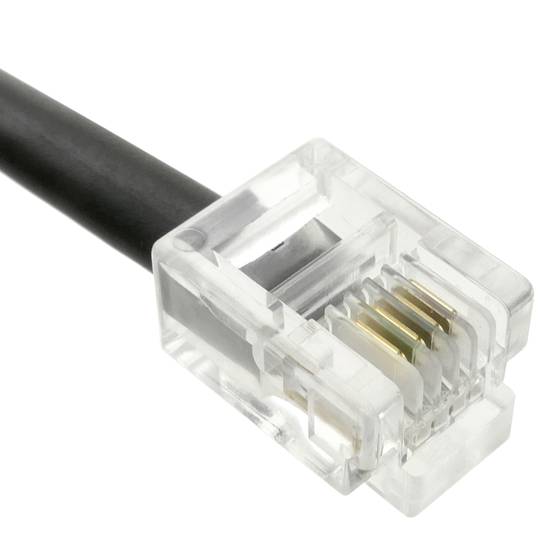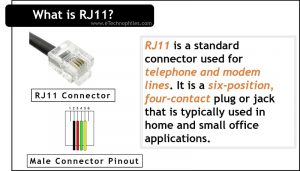Last updated on March 21st, 2024 at 11:31 am
RJ11 connector is one of the earliest versions of modular connectors used for telephone and modem lines. It is a six-position, four-conductor modular plug or jack that is typically used in home and small office applications. Although newer versions like RJ45 are now available in the market, RJ11 still prevails in the voice communication sector.
What is RJ in RJ11?
A Registered Jack, or RJ, is a standardized telecommunication network interface for connecting voice and data equipment to a service provided by a local exchange carrier or long-distance carrier. An RJ is used in both single-pair and multipair telephone systems. The most common type of Registered Jack is the RJ-45, used for Ethernet networks.
The RJ standards are defined according to the number of positions and wires in the connector. For example, RJ 11,12,14, 25, and 45 are some popular registered jacks.
These were initially called modular connectors, first invented by Bell Systems in 1973. These are introduced to establish a standardization to connect telephone lines with the distribution equipment. They could replace the protective couplers, which are different for every company. These connectors were small, comfortable to handle, and easy to manufacture.
Related: 9 Key Differences Between RJ45 and RJ11
Table of Contents
What is an RJ-11 connector?

RJ11 is a 6P4C registered jack. Its connector has 6 positions (sockets) and 4 wires.
Note: In IT, 6P6C connectors are also addressed as RJ-11. But the technical and general standard is 6P4C.
These 4 wires are used in 2 pairs to make connections. One pair of wires in it is left unused. It is considered as an extra pair, to be used in case of failure of the working pair. This jack is smaller in size compared to the other registered jacks.
RJ11 pinout and color code
As per the standard, the connector with 6 positions and 4 wires is called RJ-11. Given below is the color code description of the connector.

Note: This pinout description is in the case of RJ-11 connected to a telephone line.
Only one pair, i.e., connections 3 and 4, is used to connect with the telephone line. One extra telephone line can be connected to the remaining pin 2 and pin 5 if required.
Applications
It is mainly used in telephone lines. Since the connector has 6 positions, it can hold up to 3 telephone lines(2 wires/pair are needed for communication).
It connects a telephone with the wall socket and handset to the telephone.
RJ-11 jack or socket is available in two forms to use on telephone lines.
- RJ11C: is used on a table-top telephone. It comes with a cord to connect with the line.
- RJ11W: is used for wall telephones. It can also be used as an RJ11C jack.
Although it is mainly used in voice communication lines, older versions of fax machines and modems also use it.
These days, RJ-11 is being replaced by RJ45 on many devices. There is no need to change the setup as it can be easily plugged into the jack of RJ45.
FAQs
What is the difference between RJ11 and RJ12?
RJ12 is the successor of RJ11. RJ-11 is a 6P4C connector and RJ-12 is a 6P6C connector.
Both of them differ in the number of wires (pins/connectors). The number of positions is the same (6 positions). RJ-11 has 4 wires and RJ-12 has 6 wires. Thus, while RJ-11 connects 2 telephone lines, RJ-12 can connect 3 telephone lines.
In which cables is RJ-11 used?
RJ-11 is used in telephone lines (twisted-pair cables with 4 wires). The Cat5 cables can also be used for telephone lines with RJ-11. Just use 1 pair among the 4 pairs of wires to terminate with RJ-11 and connect to the telephone line.

